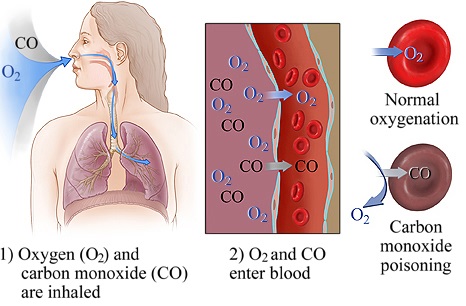Carbon Monoxide Poisoning Causes, Symptoms, Diagnosis and Treatment

What Is Carbon Monoxide Poisoning?
Carbon monoxide poisoning occurs after enough inhalation of carbon monoxide (CO).
Carbon monoxide is a toxic gas, but, being colorless, odorless, tasteless, and initially non-irritating, it is very difficult for people to detect.
When too much carbon monoxide is in the air, the body replaces the oxygen in one’s red blood cells with carbon monoxide. This can lead to serious tissue damage, or even death.
Exposure to carbon monoxide may be particularly dangerous for:
- Unborn babies.
Fetal blood cells take up carbon monoxide more readily than adult blood cells do. This makes unborn babies more susceptible to harm from carbon monoxide poisoning.
Young children take breaths more frequently than adults do, which may make them more susceptible to carbon monoxide poisoning.
- Older adults.
Older people who experience carbon monoxide poisoning may be more likely to develop brain damage.
Causes Of Carbon Monoxide Poisoning:
Carbon monoxide poisoning is caused by inhaling combustion fumes.
Sources of carbon monoxide include:
- cigarette smoke
- house fires
- faulty furnaces,
- Heaters
- wood-burning stoves
- internal combustion vehicle exhaust
- electrical generators
- propane-fueled equipment such as portable stoves
- gasoline-powered tools such as:
- leaf blowers
- lawn mowers
- high-pressure washers
- concrete cutting saws
- power trowels
- Welders
Poisoning may also occur:
- Following the use of a self-contained underwater breathing apparatus (SCUBA) due to faulty diving air compressors.
- Riding inpickup trucks
- Idling automobiles with the exhaust pipe blocked by snow
- Generators and propulsion engines on boats, especially houseboats
- by exposure to the organic solventdichloromethane, found in some paint strippers
Symptoms Of Carbon Monoxide Poisoning:
The following signs and symptoms are exhibited by those suffering from carbon monoxide poisoning:
- Dull headache
- Weakness
- Nausea or vomiting
- Shortness of breath
- Confusion
- Blurred vision
- Loss of consciousness
- Fatigue
- Cardiac abnormalities
- fast heart rate
- low blood pressure
- cardiac arrhythmia
- Central nervous system symptoms:
- delirium
- hallucinations
- Dizziness
- unsteady gait
- Confusion
- Seizures
- central nervous system depression
- unconsciousness
- respiratory arrest
- Death
- myocardial ischemia
- atrial fibrillation
- Pneumonia
- pulmonary edema
- high blood sugar
- lactic acidosis
- muscle necrosis
- acute kidney failure
- skin lesions
- visual and auditory problems
Diagnosis Of Carbon Monoxide Poisoning:
Carbon monoxide poisoning can be diagnosed via the following procedures:
- Taking a medical history
- Blood tests
- Using CO-oximeter to determine carboxyhemoglobin levels
Treatment Of Carbon Monoxide Poisoning:
Treatment of carbon monoxide poisoning may involve:
- Breathing pure oxygen
- Spending time in a pressurized oxygen chamber
- Hyperbaric oxygen therapy
By : Natural Health News




